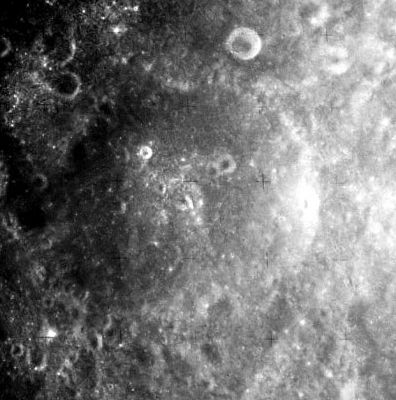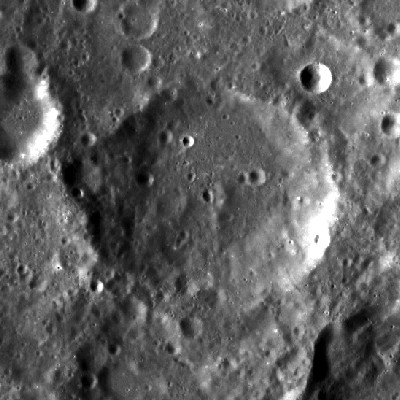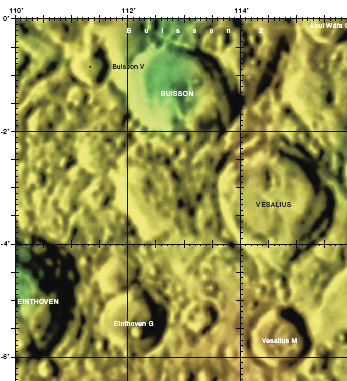Difference between revisions of "Buisson"
| Line 16: | Line 16: | ||
''([http://the-moon.us/wiki/LAC%20zone LAC zone] 83A1)'' [http://planetarynames.wr.usgs.gov/images/Lunar/lac_83.pdf USGS Digital Atlas PDF]<br /> <br /> | ''([http://the-moon.us/wiki/LAC%20zone LAC zone] 83A1)'' [http://planetarynames.wr.usgs.gov/images/Lunar/lac_83.pdf USGS Digital Atlas PDF]<br /> <br /> | ||
==Description== | ==Description== | ||
| − | '''Buisson''' lies some 500 kilometres away east from the [http://the-moon.us/wiki/Mendeleev Mendeleev Basin] -- a 365 kilometre-wide basin of the [http://the-moon.us/wiki/Stratigraphy Nectarian] period (~ 3.92 to 3.85 bn years), and about the same distance from [http://the-moon.us/wiki/Mare%20Smythii Mare Smythii] (~ 740 km, pre-Nec) in the west. The crater formed on higher ground (perhaps, on Mendeleev ejecta deposits ?) and appears well-worn where both its rim and inner region merge easily onto '''Buisson's''' relatively flat floor. The south-eastern sector of its floor is slightly higher -- is this due to material infill from influence of impact by the Nectarian-aged crater, Vesalius, nearby? If so, it may, perhaps, date the crater's age.<span class="membersnap">- | + | '''Buisson''' lies some 500 kilometres away east from the [http://the-moon.us/wiki/Mendeleev Mendeleev Basin] -- a 365 kilometre-wide basin of the [http://the-moon.us/wiki/Stratigraphy Nectarian] period (~ 3.92 to 3.85 bn years), and about the same distance from [http://the-moon.us/wiki/Mare%20Smythii Mare Smythii] (~ 740 km, pre-Nec) in the west. The crater formed on higher ground (perhaps, on Mendeleev ejecta deposits ?) and appears well-worn where both its rim and inner region merge easily onto '''Buisson's''' relatively flat floor. The south-eastern sector of its floor is slightly higher -- is this due to material infill from influence of impact by the Nectarian-aged crater, Vesalius, nearby? If so, it may, perhaps, date the crater's age.<span class="membersnap">- JohnMoore2</span><br /> <br /> |
==Description: Wikipedia== | ==Description: Wikipedia== | ||
[http://en.wikipedia.org/wiki/Buisson_(crater) Buisson]<br /> <br /> | [http://en.wikipedia.org/wiki/Buisson_(crater) Buisson]<br /> <br /> | ||
Latest revision as of 20:04, 16 April 2018
Contents
Buisson
| Lat: 1.4°S, Long: 112.5°E, Diam: 56 km, Depth: km, Rükl: (farside) | |
Right : Color-coded LAC 83 image from USGS Digital Atlas.
Images
LPOD Photo Gallery Lunar Orbiter Images Apollo Images
- AS16-113-18284 and the preceding five photographs in Apollo 16's Hasselblad-magazine 113-A, show CSM Casper above craters Buisson X' and Buisson Y. Note: the photographed regions on this kind of "high-sun" Hasselblads (shadowless albedo formations) is easy to compare with Clementines photography of the moon's equator (see also: the lower left corner of LAC 65 in Ben Bussey's and Paul Spudis's Clementine Atlas of the Moon).
Research: Danny Caes
- AS10-33-4883, made during the mission of Apollo 10, shows an unnamed bright ray-craterlet immediately west of Buisson V. The coordinates of this bright ray-craterlet are: 0°31' South/ 110°40' East.
Discovered by Nunki .
- Overlapping images AS10-28-4023 and AS10-28-4024 show the same area as in AS10-33-4883 (the bright ray-craterlets west of Buisson V).
Maps
(LAC zone 83A1) USGS Digital Atlas PDF
Description
Buisson lies some 500 kilometres away east from the Mendeleev Basin -- a 365 kilometre-wide basin of the Nectarian period (~ 3.92 to 3.85 bn years), and about the same distance from Mare Smythii (~ 740 km, pre-Nec) in the west. The crater formed on higher ground (perhaps, on Mendeleev ejecta deposits ?) and appears well-worn where both its rim and inner region merge easily onto Buisson's relatively flat floor. The south-eastern sector of its floor is slightly higher -- is this due to material infill from influence of impact by the Nectarian-aged crater, Vesalius, nearby? If so, it may, perhaps, date the crater's age.- JohnMoore2
Description: Wikipedia
The possible bright swirl-formation southeast of Buisson Y (0.5° North/ 113.3° East)
This possible swirl was captured on the following orbital Apollo photographs:
Apollo 10:
- Orbital Hasselblad photograph AS10-28-4125.
Apollo 11:
- Orbital Hasselblad photographs AS11-36-5424 (slightly above and to the left of the frame's centre), AS11-36-5426 (near the frame's lower left corner), AS11-44-6644 (near the frame's upper left corner).
Apollo 16:
- Orbital Hasselblad photographs AS16-113-18281 (near the frame's upper left corner) and AS16-113-18282 (a little bit lower than its "near-the-corner" appearance on the preceding photograph).
Apollo 16's orbital ITEK-panoramic photographs:
- Scroll rightward at both Itek-panoramic photographs of Apollo 16's orbital stereo pair AS16-P-4279 (Forward looking) and AS16-P-4284 (Aft looking).
- Near the left margin of Apollo 16's orbital Itek-panoramic photographs AS16-P-4847 and AS16-P-4849 (both Forward looking), and also AS16-P-4854 (Aft looking).
Apollo 16's orbital FAIRCHILD-Mapping/Metric photographs:
- Frame AS16-M-0496 (near the lower left corner), and its preceding frames in REV 25.
- Frames AS16-M-0626, 0627, 0628, 0629, and 0630.
Apollo 17:
- Orbital Hasselblad photographs AS17-150-23083, 23084, 23085, 23086, and 23087 (a series of five frames).
- Orbital Hasselblad photograph AS17-150-23105 (note the bright formation's hazy appearance, on the Print Resolution JPG, 4.4 MB).
- Orbital Hasselblad photographs AS17-151-23167 and AS17-151-23170.
Apollo 17's orbital ITEK-panoramic photographs:
- AS17-P-2079 (Revolution 14, Forward looking), AS17-P-2084 (Revolution 14, Aft looking).
Important: at the following two Itek photographs it's necessary to scroll rightward toward the right margin of both frames:
- AS17-P-2497 (Revolution 28, Forward looking), AS17-P-2502 (Revolution 28, Aft looking).
Observations and questions related to the possible swirl
- Note that the bright high-albedo formation doesn't "follow" the topography of the "half"crater southeast of Buisson Y itself.
- Could this be some sort of far-side equivalent of the swirl at the near-side crater Airy?
- Is this high-albedo formation (at Buisson Y) somehow related to the nearby crescent-shaped swirl field between craters Firsov, Katchalsky, and Viviani? (the swirl field at the "centre" of the flat triangle made by Firsov, Katchalsky, and Viviani).
Research Apollo photographs, detection of the possible swirl, and related observations and questions: Danny Caes
Nomenclature
- Henri Buisson (1873 – January 6, 1944) was a French physicist. In 1913 he and Charles Fabry together discovered the ozone layer.
LPOD Articles
Bibliography


